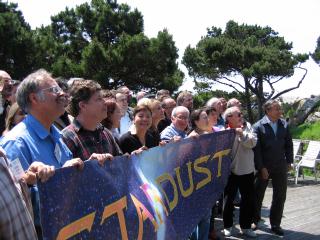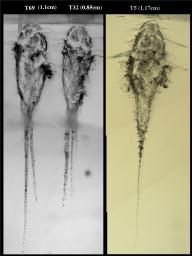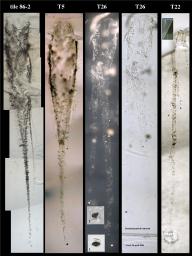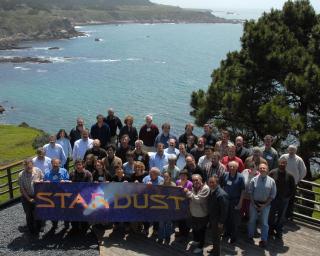
|
 |
Stardust Analysis Update
May 12, 2006
Dr. Donald Brownlee
Stardust Principal Investigator

Group photo of Stardust science team at Timber Grove Inn
near San Francisco, California
|
The Stardust Preliminary Examination Team (PET) is now in the
second half of the six month period to complete the initial
characterization of the returned comet samples. The PET consists
of about 200 people around the world organized into sub-teams
working on the bulk composition, organics, mineralogy, isotopes,
spectroscopy and craters in the aluminum holding frame. During
the first week in May, representatives of each of the six sub-teams
met to discuss the state of their findings and began outlining
the research papers that they will submit for publication this
summer. The three day workshop was held at the Timber Cove Inn,
a remote seaside location north of San Francisco. The meeting
was funded by the University of California's Institute of
Geophysics and Planetary Physics (IGPP) and organized by John
Bradley, Trish Dobson, Andrew Westphal and Gary Zank. In addition
to the comet research, one of the joys of the meeting was strolling
out on the deck to watch grey whales and their newborns migrate
up the coast.
The workshop was an opportunity to compare results, dig though
the data to see the "big picture" issues that will go into
the final research papers and plan out future work. The analysis
results came from a diverse set of instruments ranging from
optical microscopes to synchrotrons larger than shopping centers.
In addition to presentations of data, numerous discussions focused
on what had been learned about the comet. Everyone was elated
to work on ancient materials from the edge of the solar system
and there was great anticipation that this work will provide
fundamental insights into the origin of the solar system.
There was a general consensus that many of comet particles are built
like loose dirt-clods composed both of "large strong rocks"
as well as very fine powdery materials. The fine and coarse
materials are only loosely held together and they separated during
collection in low-density aerogel to form tracks shaped like
ginseng, turnips or carrots. The larger components form root-like
holes that lead to the bottoms of the tracks, and the smaller
components stopped closer to the tops of the tracks, forming
bulbous turnip-like cavities. The longest tracks are about two
centimeters long and up half a centimeter wide. Analysis of
material in the bulbs has provided the first information on
organic materials in the samples.


Comet particle tracks in aerogel.
|
Analysis of the large particles
that traveled all the way to the button of the tracks has revealed
a remarkable range of minerals. Some of these particles contain
minerals the form only at extremely high temperatures - temperatures
that could not have existed where the comets formed. Some of
these minerals are similar to "refractory" materials that
formed in the hottest, innermost regions of the disk of gas
and dust that formed the Sun and planets. If these minerals
in the comet are from our solar system then they probably formed
close to the young Sun and were transported all the way from
inside the orbit of Mercury past the orbit of Neptune.
Another option is that these "hottest minerals found in
the coldest place" actually formed around other stars. The
distinction between solar system and extra-solar origin of these
minerals will be determined by measuring their isotopic compositions.
The abundances of the isotopes of elements like oxygen is quite
different in true stardust grains, formed around other stars,
than it is for materials formed in our solar system. One of
the most exciting outcomes of the workshop was preliminary data
suggesting that the comet is a mix of both stardust grains from
other stars as well as materials formed in the solar system.
As expected, there appears to be true stardust in Stardust.
In addition to Stardust, the sponsors of the workshop also included
sessions on past and future missions. Don Burnett (Caltech)
presented the latest results from the Genesis solar wind mission
(a sister mission to Stardust), Laurie Leshin (Goddard) talked
about her work on a Martian sample return mission, using Stardust
technology, and Mike Zolensky (NASA JSC) and Scott Sandford (NASA
Ames) showed images from the Japanese Hayabusa asteroid sample
return mission. Casey Lisse (U. Maryland) presented his latest
results from the Deep Impact comet mission. One of the most
interesting findings of Deep Impact was evidence for carbonate
minerals and silicate minerals that contain bound water. To
date, these materials do not seem to exist or at least be common
in comet Wild 2 sampled by Stardust. Review talks on comet
mineralogy, Calcium Aluminum Inclusions and the formation of
the solar system were given respectively by Diane Wooden (NASA
Ames), Glen McPherson (Smithsonian) and Doug Lin (UC Santa Cruz).
A highlight of the entire meeting was a panel discussion by
several of the above speakers plus Dave Lindstrom (NASA HQ)
and Jerry Wasserburg (Caltech).
Together they advised the PET to take care to see the forest
through the trees and write meaningful final reports that will
be widely read. Jerry gave great advice and talked about Stardust
and its work on the first comet samples in comparison with Apollo
11 and his first look at samples from the Moon, 35 years before.

Another group photo of Stardust science team
|
It was a wonderful meeting and the team left fully charged to
complete the rest of its 6 month initial examination of the
comet samples. The looks on the faces in the above picture
express the wonder and excitement of the meeting. All
of the people in the picture played major roles in Stardust.
Jerry Wasserburg is on the right holding up the banner and Peter
Tsou Deputy PI is on his right. Peter and Ben Clark, just behind Jerrry,
have been with Stardust since its beginnings over a decade ago.
Last Updated: May 12, 2006
|
